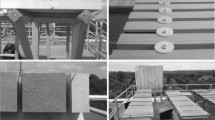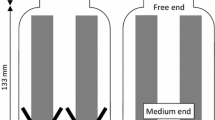Abstract
Decay models are key elements for service life prediction and performance classification of wooden products and timber structures. Available models differ in terms of data sources used and prevailing decay types considered. Comparative studies on performance models are therefore rare. In this study we applied data sets from field tests dominated by brown rot decay to a model developed on the basis of white and soft rot decay. Differences in time till colonization, onset of decay and subsequent decay progress between the rot types were found. Brown rot decay turned out to be initiated earlier and proceed faster compared to white and soft rot decay. Microclimate was influenced by shading within this study, whereby the moisture and temperature induced dose was affected as well as the progress of brown rot decay itself. Consequently, for obtaining a more conservative decay model only data sets dominated by brown rot and unaffected by shading were used. The brown model shortened the expected lifetime by 50 % compared to the previous white and soft rot model for a given dosage.







Similar content being viewed by others
References
Augusta U (2007) Untersuchung der natürlichen Dauerhaftigkeit wirtschaftlich bedeutender Holzarten bei verschiedener Beanspruchung im Außenbereich (Natural durability fo european wood species in different use classes). Doctoral thesis, University Hamburg, Faculty of Mathematics, Informatics and Natural Sciences, Department Biology
Brischke C (2007) Untersuchung abbaubestimmender Faktoren zur Vorhersage der Gebrauchsdauer feuchtebeanspruchter Holzbauteile (Investigation of decay influencing factors for service life prediction of exposed wooden components). Doctoral thesis, University Hamburg, Faculty of Mathematics, Informatics and Natural Sciences, Department Biology
Brischke C, Alfredsen G, Flæte P-O, Humar M, Isaksson T, Meyer L (2015) The combined effect of wetting ability and durability on field performance—verification of a new prediction approach. The International Research Group on Wood Protection, IRG/WP/15-20565, Stockholm
Brischke C, Lampen SC (2014) Resistance based moisture content measurements on native, modified, and preservative treated wood. Eur J Wood Wood Prod 72:289–292
Brischke C, Rapp AO (2008) Influence of wood moisture content and wood temperature on fungal decay in the field: observations in different micro-climates. Wood Sci Technol 42:663–677
Brischke C, Rapp AO (2010) Service life prediction of wooden components—Part 1: Determination of dose response functions for above ground decay. The International Research Group on Wood Protection, IRG/WP/10-20439, Stockholm
Brischke C, Rapp AO, Bayerbach R (2008) Measurement system for long-term moisture recording with internal conductively glued electrodes. Build Environ 43:1566–1574
Brischke C, Thelandersson S (2014) Modelling the outdoor performance of wood products—a review on existing approaches. Constr Build Mater 66:384–397
Clausen CA, Lindner DL (2011) Shading aboveground L-joint and lap-joint tests: comparison of white pine and sugar maple test assemblies. For Prod J 61:265–269
Edlund M-L (1998) Durability of untreated wood exposed in terrestrial test fields and microcosms. Mater Organ 32:253–275
European Committee for Standardization (1990) EN 252. Wood preservatives. Field test methods for determining the relative protective effectiveness in ground contact
European Committee for Standardization (1994) EN 350-2. Durability of wood and wood based products—natural durability of solid wood—Part 2: Guide to the natural durability and treatability of selected wood species of importance in Europe
European Committee for Standardization (2005) CEN/TS 15083-2. Durability of wood and wood-based products—determination of the natural durability of solid wood against wood-destroying fungi, test methods—Part 2: Soft rotting micro-fungi
Frühwald Hansson E, Brischke C, Meyer L, Isaksson T, Thelandersson S, Kavurmaci D (2012) Durability of timber outdoor structures: modelling performance and climate impacts. In: World conference on timber engineering, Auckland. 16–19 July 2012
Huckfeldt T, Schmidt O (2006) Hausfäule- und Bauholzpilze. Diagnose und Sanierung. Rudolf Müller, Cologne
Ibach RE, Gnatowski M, Sun G (2013) Field and laboratory decay evaluations of wood-plastic composites. For Prod J 63:76–87
Isaksson T, Brischke C, Thelandersson S (2012) Development of decay performance models for outdoor timber structures. Mater Struct 46:1209–1225
Isaksson T, Thelandersson S, Jermer J, Brischke C (2014) Beständighet för utomhusträ ovan mark. Guide för utformning och materialval. Rapport TVBK-3066. Lund University, Division of Structural Engineering, Lund
Jacobs K, Rangno N, Scheiding W, Weiß B, Müller D, Hiller C, Brabetz W (2010) Detection of wood destroying fungi using DNA microarray technology. The International Research Group on Wood Protection, IRG/WP/10-20435
Leicester RH, Wang C-H, Cookson LJ (2008) A reliability model for assessing the risk of termite attack on housing in Australia. Reliab Eng Syst Saf 93:468–475
MacKenzie CE, Wang C-H, Leicester RH, Foliente GC, Nguyen MN (2007) Timber service life guide. Forest and Wood Products Limited, Victoria
Meyer L, Brischke C (2015) Fungal decay at different moisture levels of selected European-grown wood species. Int Biodeter Biodegr 103:23–29
Meyer L, Brischke C, Treu A, Larsson-Brelid P (2015) Critical moisture conditions for fungal decay of modified wood by basidiomycetes. Holzforschung. doi:10.1515/hf-2015-0046
Meyer L, Brischke C, Rieken J (2013) Testing the performance of timber using 27 different field test methods. The International Research Group on Wood Protection, IRG/WP/13-20517, Stockholm
Morris PI, Wang J (2011) Scheffer index as preferred method to define decay risk zones for above ground wood in building codes. Int Wood Prod J 2:67–70
Pfeffer A, Hoegger PJ, Kües U, Militz H (2012) Fungal colonisation of outside weathered modified wood. Wood Sci Technol 46:63–72
Prewitt L, Kang Y, Kakumanu ML, Williams M (2014) Fungal and bacterial community succession differs for three wood types during decay in a forest soil. Microb Ecol 68:212–221
Råberg U, Brischke C, Rapp AO, Högberg NO, Land CJ (2007) External and internal fungal flora of pine sapwood (Pinus sylvestris L.) specimens in above-ground field tests at six different sites in south-west Germany. Holzforschung 61:104–111
Råberg U, Daniel G, Terziev N (2012) Loss of strength in biologically degraded thermally modified wood. BioResources 7:4658–4671
Rapp AO, Augusta U (2004) The full guideline for the “double layer test method”—a field test method for determining the durability of wood out of ground. The International Research Group on Wood Protection, IRG/WP/04-20290, Stockholm
Saito H, Fukuda K, Sawachi T (2012) Integration model of Hygrothermal analysis with decay process for durability assessment of building envelopes. Build Sim 5:315–324
Scheffer TC (1971) A climate index for estimating potential for decay in wood structures above ground. For Prod J 21:25–31
Van de Kuilen J-WG (2007) Service life modelling of timber structures. Mater Struct 40:151–161
Van der Wal A, Ottosson E, de Boer W (2015) Neglected role of fungal community composition in explaining variation in wood decay rates. Ecology 96:124–133
Vereecken E, Roels S (2012) Review of mould prediction models and their influence on mould risk evaluation. Build Environ 51:296–310
Viitanen H (1997) Modelling the time factor in the development of brown rot decay in pine and spruce sapwood—the effect of critical humidity and temperature conditions. Holzforschung 51:99–106
Viitanen H, Ritschkoff A-C (1991) Brown rot decay in wooden constructions. Effect of temperature, humidity and moisture. Swedish University of Agricultural Sciences, Department of Forest Products, Report No. 222
Viitanen H, Toratti T, Makkonen L, Peuhkuri R, Ojanen T, Ruokolainen L, Räisänen J (2010) Towards modeling of decay risk of wooden materials. Eur J Wood Wood Prod 68:303–313
Acknowledgments
The authors are grateful for financial support from WoodWisdom-Net (www.woodwisdom.net) and wood industry partnership in the frame of the WWN project “Durable Timber Bridges DuraTB”.
Author information
Authors and Affiliations
Corresponding author
Rights and permissions
About this article
Cite this article
Brischke, C., Meyer-Veltrup, L. Modelling timber decay caused by brown rot fungi. Mater Struct 49, 3281–3291 (2016). https://doi.org/10.1617/s11527-015-0719-y
Received:
Accepted:
Published:
Issue Date:
DOI: https://doi.org/10.1617/s11527-015-0719-y




